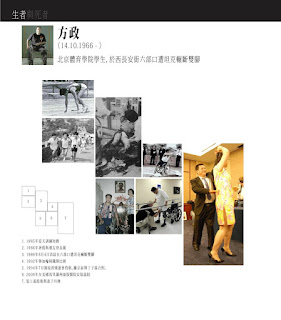關於「生者與死者」 "Survivors and the Dead"-「六四」屠殺實物展
下載內容 PDF
展期:2015年4月4日
死者長已矣,生者猶悲歌。
「六四」屠殺迄今26年,對於真相的釐清、責任的追究,這是段太長的時間;對於歷史傷痛的遺忘,這又是太短了。26年,血淚仍然未乾,真相豈容歪曲。
「天安門廣場未開過一槍、未打死打傷一人」,當年國務院發言人袁木如是說,信訪局的覆函如是說。然而,「六四」倖存者張健在天安門廣場中槍的子彈就在眼前。
「他是暴徒,你再廢話就斃了你!」當年士兵惡狠狠地阻撓民眾搶救王楠,然而他不過是個想拍攝歷史鏡頭的高中生,另一遇難者吳向東更是共青團團員。在已知202名遇難者中,年齡最小的僅9歲,他們是暴徒嗎?
「天安門母親」丁子霖說過,在「六四」後的那些日日夜夜,她曾在生與死之間幾度徘徊,最終選擇了生,她活下去就是要為死者討回公道,為生者求得正義。而這,也是這次實物展覽的意義。
吳向東(13.8.1968-4.6.1989)
工人、夜校學生,於木樨地橋頭附近中彈,遇難時21歲
● 1989年5月21日,吳向東於天安門廣場寫下遺書,當中提到「我作好了與學生同在的準備,就是死了也在所不惜。這是為了民主和自由。」圖為吳向東父親吳學漢手抄兒子遺書。
● 寫有「愛國無罪」的頭巾
● 相機及膠卷,留下吳向東遇難前拍攝的八九民運照片。
● 星辰(CITIZEN)手錶
● 共青團團員證、章程;吳向東17歲入東風電視機廠工作,其後成為該廠共青團宣委。
● 學生證;吳向東入廠後半工讀,考上北京成人理工大學的電子儀錶夜大學(工業企業管理專業)。
● 普及法律常識合格證書
● 手提包
● 寫滿簽名的襯衫
● 汽車月票、年曆卡
● 八九民運期間攝於天安門廣場
● 吳向東遺照,頸部有明顯傷口。
王楠(3.4.1970-4.6.1989)
高中生,於天安門西側南長街南口中彈,遇難時19歲
● 留有子彈孔的頭盔,子彈從王楠左上額射入、左耳後穿出。
● 遇難時所帶眼鏡,左邊鏡片被打碎。
● 寫有「中國魂」等字句的抗議布條
● 手帕
● 1989年6月20日,北京市公安局發出的屍體火化證明,僅寫「在外死亡」。
● 1989年6月26日,由北京市衛生局及北京市公安局發出的死亡報告單,註明「槍傷在外死亡」,但死亡原因和地點皆為空白。
● 北大傳單
● 《告全國愛國同胞書》
張健(11.11.1970-)
學生糾察隊隊長,在天安門東觀禮台對面的天安門廣場被連射3槍,其中一顆子彈留在體內19年
● 變了形的子彈頭,2008年在法國做手術取出。
● 同類型子彈
● 右大腿股骨幹上三分之一處粉碎性骨折,圖為腿部槍傷X光片。
● 子彈未取出前,右大腿根處皮膚凸起。
● 歌手崔健在廣場舉行搖滾樂晚會,張健累極席地而睡。
● 頭綁抗議布條,在廣場擔任糾察隊隊長。
● 於同仁醫院留醫,右腿吊了128天。
北京體育學院學生,於西長安街六部口遭坦克輾斷雙腳
● 1985年夏天,田徑運動員方政在短跑訓練中準備起跑。
● 1986年暑假與朋友登長城
● 1989年6月4日清晨,坦克衝向正在撤退的學生隊伍,方政為拯救女同學遭坦克輾斷雙腳。
● 1992年參加廣州第三屆全國殘疾人運動會輪椅鐵餅比賽
● 1994年7月,方政被取消「遠東及南太平洋殘疾人運動會」參賽資格,强行遣送回海南,離京前一天與丁子霖合照。
● 2009年8至10月,美國馬里蘭州康復醫院的專家為方政製作義肢,並訓練使用義肢。
● 裝上義肢後的方政,終於可以重新「站」起來,與妻子共舞。
影帶說明:
● 生者的故事
一顆留在體內19年的子彈,張健成為了「六四」天安門廣場屠殺的「鐵證」,但他說:「要是真的有一個仇恨的子彈,希望這是一顆最後的子彈。」
兩度被政治摧毀的運動健將,方政在失去雙腳後,再被剝奪殘運會參賽資格。然而腿可斷志不可屈,他最終赴美國安裝義肢,重新「站」起來。
● 死者的故事
母親覆述兒子遭槍殺過程,是多麼痛苦的事。子彈射穿頭顱、軍隊阻撓搶救、屍體就地掩埋、發出惡臭……這一幕幕在王楠母親張先玲口中說出,仍怵目驚心。她希望有更多人勇敢拿出證物,還原歷史真相。
父親重抄年輕兒子的遺書,又是何等沉重。吳向東遇難後,留下一筒膠卷、一個大好青年未完的故事;其父吳學漢抑鬱過度,數年後含恨而終,留下尚未昭雪的冤屈。
Survivors and the Dead
Fang Zheng (14 October 1966 - )
Fang was a student of Beijing Sports University. In the early morning of June 4, Fang was run over by a tank when he was trying to save a female student, which led to the amputation of both his legs. He went to the United States to have prosthetic legs fitted and was able to walk again. According to Fang, he may not be as courageous as Wang Weilin, who obstructed the advance of a column of tanks, but from another point of view, he is a more convincing example of the brutality of the Chinese troops in the June 4 Massacre.
Fang Zheng used to be a competitive athlete. After losing both of his legs in the June 4 Massacre, Fang was persecuted, being barred from competing in the Far East and South Pacific Games for the Disabled.
Zhang Jian (11 November 1970 - )
Zhang was a leader of the team of student marshal. He came from a military family. At midnight of June 4, 1989, Zhang was shot three times by a soldier at Tiananmen Square. One of the bullets has been lodged in his body for 19 years. Zhang once said, “If ‘bullets of hatred’ can be said to exist, I hope this will be the last one.”
Complex fracture on the upper third of Zhang Jian’s right femoral shaft. X-rays of the gunshot wounds to his legs.
Wang Nan (3 April 1970 - 4 June 1989)
At midnight of June 4, 1989, Wang, a high school student who was just 19, put on a helmet and went to Tiananmen Square. He was there to take historic photos but died after being shot in the head. After Wang was shot, the martial law troops obstructed civilians from treating him. He was hastily buried on the spot after he died. His family was only able to find his body three days later.
The exhibition will show :-
- The helmet Wang was wearing when he died. The bullet entered through his upper left forehead and exited through the back of his left ear. The bullet hole on the helmet is clearly discernible.
- The protest headbands Wang was wearing:
- soul of China
- rule by law, democracy
- right=? wrong=?
Wu Xiangdong (13 August 1968 – 4 June 1989)
After seeing his girlfriend off at 8 p.m. on 3 June 1989, Wu was shot in the neck at around 11 p.m. near one end of Muxidi bridge. He died in Fuxing Hospital at midnight on June 4. He was just 21 years old.
Wu’s possessions represent those of typical Chinese teenagers at that time: once a member of the Young Pioneers of China, he became a worker after graduating from middle school. He studied in his spare time and later became the commissar in charge of publicity for the Communist Youth League of China. During the 1989 Democracy Movement, he went to Tiananmen Square to support the students nearly everyday. A lot of students signed his shirt, a memento popular at the time. On May 21, 1989, Wu wrote a letter in Tiananmen Square before he was killed in the June 4 Massacre.







